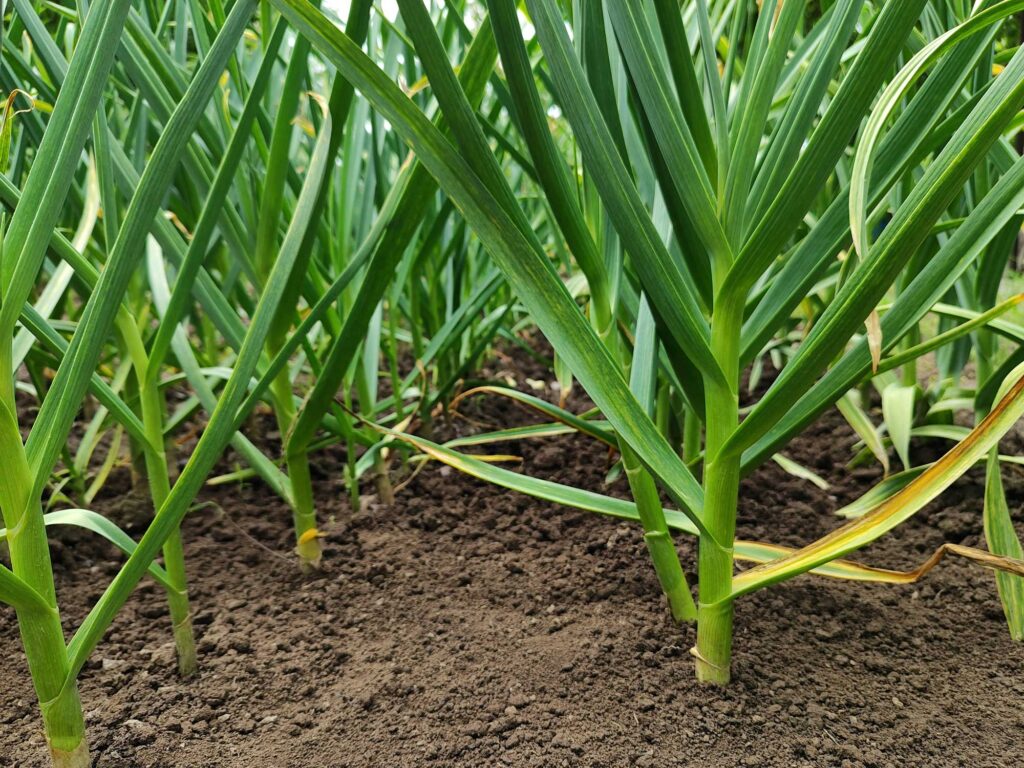Most people think of fall as time to plant tulips and daffodils, but it’s also when you need to plant one of the kitchen’s most used flavors: garlic!
Yes, in the northern US, the time to plant garlic is fall. We in the Black Hills of South Dakota need to get garlic in the ground after the first killing frost but before the ground freezes.
And we need to plant hardneck garlic, which is the number one reason you should be sure to buy seed garlic at a local store and not just plant what you buy at the grocery store. Almost all grocery store garlic is softneck, which is grown in warmer climates with a longer growing season. Happily, hardneck garlic has larger cloves and is easier to peel so it’s better for cooking anyway!
Garlic needs to be planted when the soil is warm enough for it to start developing roots, but then needs to go through vernalization (a cold period of at least 4-6 weeks) in order to form a bulb. You may or may not see green shoots growing in the fall.

In early spring, you’ll see green shoots coming up and in early summer the plant will send up a scape, which is a curly stalk that will bloom if you allow it to. However, you want the plant to put its energy into forming a bulb, so you’ll want to trim those scapes. They are delicious when sauteed in butter!

Later in the summer, the garlic plant will begin turning brown from the bottom up, which signals it’s ready to harvest. Each leaf on the stalk represents one layer of paper around the bulb, so wait until about half of them are brown and then you can gently dig up your bulbs and hang them by the stalk to dry.
Garlic is truly one of the easiest vegetables to grow, as it is not much bothered by pests and requires little care from planting to harvest other than some supplemental watering during dry spells (thankfully not too much, since it can rot if there’s too much moisture).
How to plant garlic
To plant, break apart the cloves on each bulb but leave them in their paper wrappers.
Garlic likes “fertile, well-drained soil” (doesn’t everything?) so if your soil is heavy, it’s a good idea to mix compost with your soil to aid in drainage. For the best results, as you fill in your holes you can mix in a tablespoon of fish bone meal or an all-purpose vegetable fertilizer per clove to give it plenty of nutrients.
Plant about 2-4 inches deep and six inches apart, with the pointy side up and the root side down. If you’ll be mulching well, you can do two-ish inches and then add several inches of mulching material like wool, wood chips, or straw.
Water well and you’re done for the winter.
In spring, be sure the weeds don’t take over but if you mulched heavily, you’ll likely have very little weeding to do. A nitrogen fertilizer can be added when you start to see green growth in the spring.

Harvest the scapes when they appear in early summer, and then harvest after about half of the leaves have died back. Gently dig up the bulb without trimming off the stalk, then lay or hang in a dry, well-ventilated place until roots and stalks are completely dry. At this point you can trim off the stalk and store for winter.

We have a sale on our seed garlic! Starting 10/10/24 and while supplies last, buy one head of seed garlic and get three shallot clumps for free. Time to get both of these in the ground if you are in the Black Hills! Our store in Hot Springs is open 9-6 Tues-Fri and 9-2 on Saturday – here’s our location.
Photos by Anna Evans, Tobias, and Frédéric Dupont on Unsplash